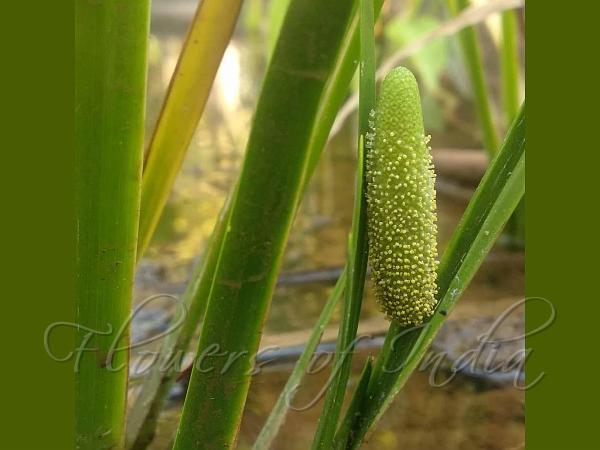|
| Sweet Flag |
|

|

|
|
|
|
Photo: |
Botanical name: Acorus calamus Family: Araceae (Arum family)
Sweet Flag is a perennial herb 1-4 ft tall, consisting of tufts of basal
leaves that emerge directly from a spreading rootstock. These basal leaves
are erect and sword-shaped, resembling Iris leaves. They are flattened,
smooth along the margins, and have parallel veins. There is often an
off-center ridge/indentation along the length of each leaf. Sometimes the
base of the leaves or their margins are slightly red. The inflorescence is
a cylindrical spadix that is about 2–4 inches in length and semi-erect.
This spadix is covered with tiny greenish yellow flowers in a diamond-
shaped pattern. Each flower has 6 tepals and 6 stamens. The covering
spathe, which is found in many plants of the same family, is absent here.
The blooming period occurs from late spring to early summer and lasts
about a month. Both the crushed foliage and rootstocks have a pleasant
aromatic fragrance. The root system consists of shallow branching rhizomes
that are stout and knobby. Tufts of basal leaves occur at intervals
along these rhizomes, while coarse fibrous roots develop below. This plant
multiplies by its rhizomes.
Sweet Flag is found in the Himalayas, at altitudes of 100-2300 m and Western
Ghats. Flowering: March-May.
Medicinal uses: The rhizome of Sweet Flag is very pungent and bitter
in taste. It helps to promote memory, longevity and good voice.
The rhizome of Sweet Flag is very pungent and bitter
in taste. It helps to promote memory, longevity and good voice.
Medicinal uses:
 The rhizome of Sweet Flag is very pungent and bitter
in taste. It helps to promote memory, longevity and good voice.
The rhizome of Sweet Flag is very pungent and bitter
in taste. It helps to promote memory, longevity and good voice. | Identification credit: Tabish | Photographed in Maharashtra & Delhi. |
• Is this flower misidentified? If yes,